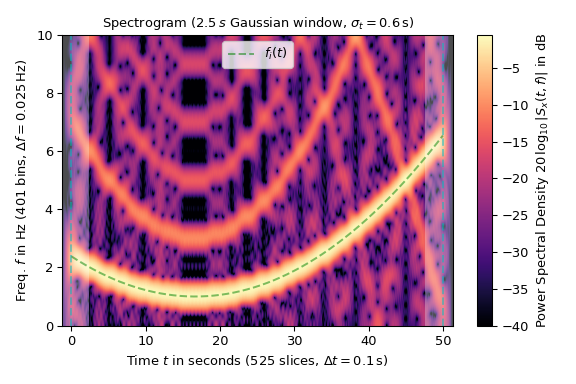scipy.signal.ShortTimeFFT.spectrogram#
- ShortTimeFFT.spectrogram(x, y=None, detr=None, *, p0=None, p1=None, k_offset=0, padding='zeros', axis=-1)[source]#
Calculate spectrogram or cross-spectrogram.
The spectrogram is the absolute square of the STFT, i.e, it is
abs(S[q,p])**2for givenS[q,p]and thus is always non-negative. For two STFTsSx[q,p], Sy[q,p], the cross-spectrogram is defined asSx[q,p] * np.conj(Sx[q,p])and is complex-valued. This is a convenience function for callingstft/stft_detrend, hence all parameters are discussed there. If y is notNoneit needs to have the same shape as x.See also
stftPerform the short-time Fourier transform.
stft_detrendSTFT with a trend subtracted from each segment.
scipy.signal.ShortTimeFFTClass this method belongs to.
Examples
The following example shows the spectrogram of a square wave with varying frequency \(f_i(t)\) (marked by a green dashed line in the plot) sampled with 20 Hz:
>>> import matplotlib.pyplot as plt >>> import numpy as np >>> from scipy.signal import square, ShortTimeFFT >>> from scipy.signal.windows import gaussian ... >>> T_x, N = 1 / 20, 1000 # 20 Hz sampling rate for 50 s signal >>> t_x = np.arange(N) * T_x # time indexes for signal >>> f_i = 5e-3*(t_x - t_x[N // 3])**2 + 1 # varying frequency >>> x = square(2*np.pi*np.cumsum(f_i)*T_x) # the signal
The utitlized Gaussian window is 50 samples or 2.5 s long. The parameter
mfft=800(oversampling factor 16) and thehopinterval of 2 inShortTimeFFTwas chosen to produce a sufficient number of points:>>> g_std = 12 # standard deviation for Gaussian window in samples >>> win = gaussian(50, std=g_std, sym=True) # symmetric Gaussian wind. >>> SFT = ShortTimeFFT(win, hop=2, fs=1/T_x, mfft=800, scale_to='psd') >>> Sx2 = SFT.spectrogram(x) # calculate absolute square of STFT
The plot’s colormap is logarithmically scaled as the power spectral density is in dB. The time extent of the signal x is marked by vertical dashed lines and the shaded areas mark the presence of border effects:
>>> fig1, ax1 = plt.subplots(figsize=(6., 4.)) # enlarge plot a bit >>> t_lo, t_hi = SFT.extent(N)[:2] # time range of plot >>> ax1.set_title(rf"Spectrogram ({SFT.m_num*SFT.T:g}$\,s$ Gaussian " + ... rf"window, $\sigma_t={g_std*SFT.T:g}\,$s)") >>> ax1.set(xlabel=f"Time $t$ in seconds ({SFT.p_num(N)} slices, " + ... rf"$\Delta t = {SFT.delta_t:g}\,$s)", ... ylabel=f"Freq. $f$ in Hz ({SFT.f_pts} bins, " + ... rf"$\Delta f = {SFT.delta_f:g}\,$Hz)", ... xlim=(t_lo, t_hi)) >>> Sx_dB = 10 * np.log10(np.fmax(Sx2, 1e-4)) # limit range to -40 dB >>> im1 = ax1.imshow(Sx_dB, origin='lower', aspect='auto', ... extent=SFT.extent(N), cmap='magma') >>> ax1.plot(t_x, f_i, 'g--', alpha=.5, label='$f_i(t)$') >>> fig1.colorbar(im1, label='Power Spectral Density ' + ... r"$20\,\log_{10}|S_x(t, f)|$ in dB") ... >>> # Shade areas where window slices stick out to the side: >>> for t0_, t1_ in [(t_lo, SFT.lower_border_end[0] * SFT.T), ... (SFT.upper_border_begin(N)[0] * SFT.T, t_hi)]: ... ax1.axvspan(t0_, t1_, color='w', linewidth=0, alpha=.3) >>> for t_ in [0, N * SFT.T]: # mark signal borders with vertical line ... ax1.axvline(t_, color='c', linestyle='--', alpha=0.5) >>> ax1.legend() >>> fig1.tight_layout() >>> plt.show()

The logarithmic scaling reveals the odd harmonics of the square wave, which are reflected at the Nyquist frequency of 10 Hz. This aliasing is also the main source of the noise artifacts in the plot.